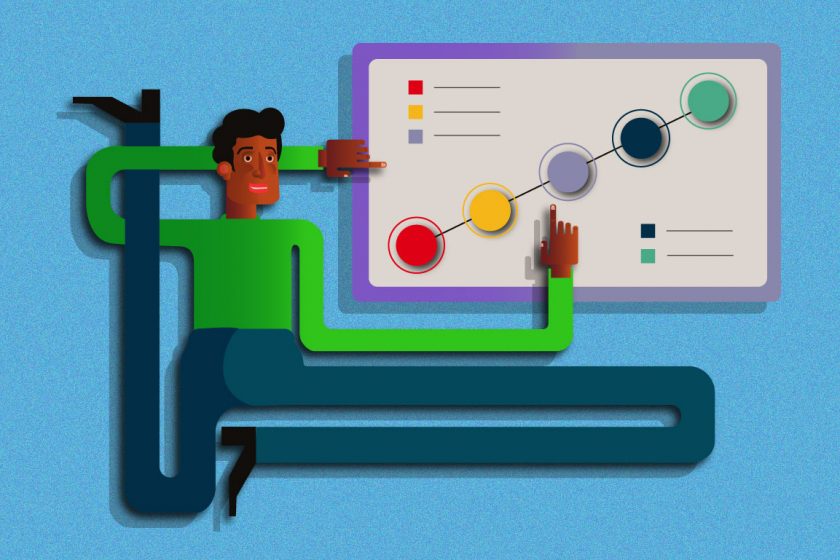Resource management is the process of determining what resources are needed, in what quantities, and when to use them to complete a project.
CONTENT
- What is a resource management plan?
- Why is the creation of a resource plan important?
- 1. It helps achieve efficient planning of project resources
- 2. Minimizes project resource costs
- 3. Helps to deliver the project on time and within budget
- Creating a resource management plan: 5 tips
- 1. Determine the resources needed for your project
- 2. Matching the right resources to the right tasks
- 3. Keeping track of the project’s progress
- 4. Make changes if necessary
- 5. Perform post-project analysis
In addition, this process also helps predict the cost and timeline associated with a project.
Organizing these resources efficiently to ensure the proper execution of the work requires adequate planning.
This article will discuss 5 tips for creating a resource management plan.
What is a resource management plan?
A resource management plan is a program that guides how project resources are to be classified, allocated, managed, and released.
Here are some of the components of a good resource management plan:
- Resources include team members, machinery, equipment, and space needed to complete the project.
- Timing: keeping track of the time availability of each resource will give a better picture of how each can fit into the overall schedule.
- Quantity: quantity generally refers to physical resources and is yet another crucial element in planning work effectively.
- Assumptions and constraints: assumptions may include assumptions about employee availability, assumptions about work commitments, etc. Limitations relate to project schedule, cost, and scope.
- Roles and responsibilities: in order to avoid conflicts within the project, it is necessary to clarify the roles and responsibilities of each member working on it.
Why is the creation of a resource plan important?
1. It helps achieve efficient planning of project resources
It is desirable to complete a project, but not having sufficient resources to carry out the work necessarily leads to gridlock, delays, and an impact on quality.
An intelligent resource plan helps the project manager anticipate all needs.
This way, it is possible to allocate a resource or consider hiring one if necessary.
2. Minimizes project resource costs
An effective resource plan helps the project manager make data-driven decisions and implement the proper measures at the right time.
This way, all resources are allocated in the most cost-effective way possible, helping keep project costs to a minimum.
Likewise, efficient management maximizes the profitable use of resources.
3. Helps to deliver the project on time and within budget
The benchmark for successful delivery is meeting project deadlines and avoiding overbudgeting.
A good staffing plan helps the project manager periodically review project performance using forecast reports compared to the actual ones.
Regular monitoring will then lead to the achievement of project metrics such as customer satisfaction, improved quality, or increased brand loyalty.
Creating a resource management plan: 5 tips
Once you have seen what a resource management plan is, here are 5 tips for creating one:
1. Determine the resources needed for your project
Determining what resources are required to complete your project is the first step in drafting a proper resource management plan.
This information can come from knowledge of the project, understanding the goals and activities and comparing them with the skills of the resources, or using previous successful similar projects as a guide (lesson learned).
2. Matching the right resources to the right tasks
Effective resource management means aligning project needs with the most appropriate resources.
It is crucial to ensure that the tasks set are aligned with the resource’s skills and that the resource has the time available to complete the assigned tasks.
To plan resources accurately, the project manager should consider not only what needs to be done with the current project but also all current or recurring projects that the same resource is engaged in completing.

3. Keeping track of the project’s progress
It is easier to fix a potential problem before it arises than to try to repair the damage that has already been done.
This means that the earlier problems in resource management are perceived, the easier it will be to find a solution.
The project manager must therefore keep an eye on the project throughout its life cycle, regularly observing and monitoring how actual performance compares with the planned resource allocation.
4. Make changes if necessary
In any project, it is important to expect that only some things will always go as planned.
A project manager must be ready to make changes and adjustments if the situation requires it.
5. Perform post-project analysis
At the end of the work, comparing the planned resources and planning with what was actually used is good practice.
These lessons help avoid mistakes in the future, especially in the case of similar projects.
In addition to reviewing reports, it is also useful to interview resources directly to get another perspective and see if they feel the project went smoothly or if they have any ideas for improving processes.
Resource management, therefore, requires real-time data to keep track of chttps://twproject.com/cost-management/osts and timelines spent to keep the project on track.
While spreadsheets can do a satisfactory job for simple projects, this can become very difficult in the case of more complicated projects.
Scheduling resources in this way can become virtually impossible when the team expands, and you start tackling multiple projects at once.
This is where good project management software becomes necessary.
This resource management tool provides relevant and timely information allowing the project to stay on track.



